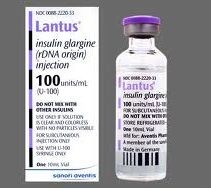Glargine insulin (Lantus)
Basic information
- Glargine must not be diluted or mixed with anything because the prolonged action is dependent on its pH
- Glargine has a shelf-life of 4 weeks after opening and kept at room temperature. Refrigeration prolongs its shelf-life and allows opened vials to be used for up to 6 months. The manufacturer however recommends discarding opened vials after 4 weeks
- When performing a blood glucose curve, samples probably only need to be taken every 4hrs over 12 hr in many cats (ie. 0h [before morning insulin], 4h, 8h and 12h after morning insulin)
- Dose changes should be made based on pre-insulin glucose concentration, nadir (lowest) glucose concentration, daily water drunk, and urine glucose concentration.
- Better glycaemic control is achieved with twice daily dosing rather than once daily
- More accurate dosing may be achieved using 0.3ml U-100 insulin syringes
Indications for starting glargine
- All newly diagnosed diabetic cats (to increase chance of remission)
- Poorly controlled or unstable diabetic cats (glargine’s long duration of action is likely to benefit these cats)
- When SID dosing is desired or demanded (glycaemic control and remission rates are higher if glargine is dosed BID)
- Ketoacidosis – replaces regular insulin and can be used IM or IV
- When corticosteroid administration is required in cats at high risk of developing clinical signs of diabetes or cats in remission.
For initial insulin dose,
- BG > 20mmol/L à start with 0.5U/kg ideal body weight twice daily (BID)
- BG < 20mmol/L à start with 0.25U/kg ideal body weight BID
Blood glucose should be sampled every 3-4hrs for several days, either at home or in hospital. Dose reductions can be made (based on the blood glucose parameters in Table 1) but it is suggested that you do not increase the dose until about 7 days of therapy as many cats have negligible glucose lowering effect in the first few days despite being on an adequate dose of insulin.
After this, cats should have their blood glucose sampled weekly (or more frequently) as outpatients and insulin dose adjusted according to Table 1. If biochemical hypoglycaemia develops and is not severe, it can usually be managed by feeding the cat a higher carbohydrate containing meal. Renal diets and many supermarket lines of dry food are high in carbohydrates. Clinical hypoglycaemia requires immediate IV glucose therapy.
Table 1. Blood glucose parameters used for adjusting insulin dose
| Blood Glucose Parameter | Insulin Dose | |
| Pre-insulin >20mmol/L | increase 0.5U | |
| Pre-insulin 15-20mmol/L and/or nadir 7-9mmol/L |
SAME | |
| Pre-insulin 12-14mmol/L | reduce by 0.5U | |
| Pre-insulin <12mmol/L | withhold and check for remission | |
| nadir 5-7mmol/L | reduce by 0.5U | |
| Nadir <5mmol/L | reduce by 1U | |
| Clinical hypoglycemia | reduce by 50% |


